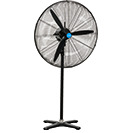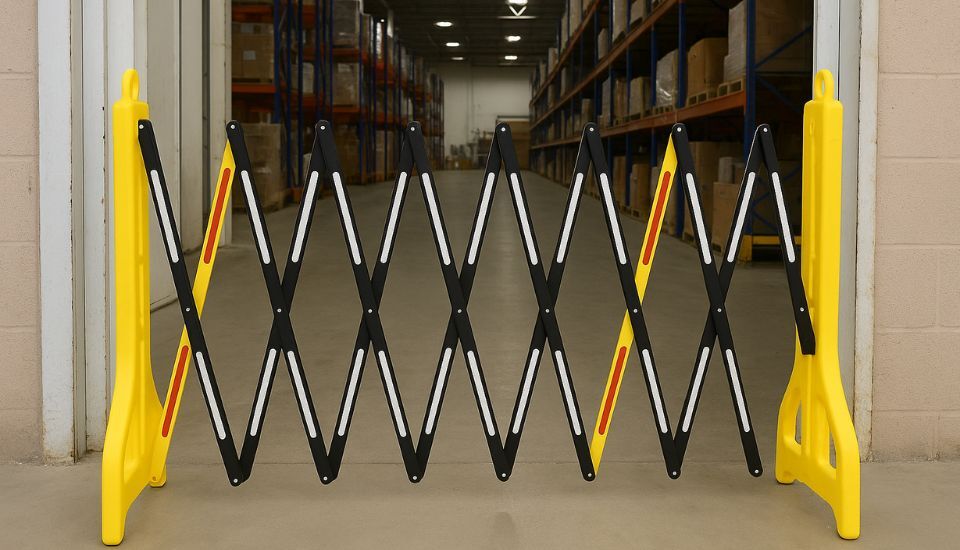6 Strategic Uses of Safety Barriers in High-Traffic Work Areas
Date Posted:4 September 2025
From warehouses to construction sites, high-traffic zones are hazardous. Learn 6 strategic ways safety barriers keep people, assets, and workflows safe.
Verdex Insights: At a Glance
-
The Challenge: In busy industrial environments, pedestrians and vehicles often operate in close proximity. Without clear separation, the risk of collisions, injuries, and damage to property increases significantly.
-
The Insight: Segregating pedestrian and vehicle zones with safety barriers, guardrails, and bollards is one of the most effective ways to reduce accidents, improve workflow, and maintain WHS compliance. Properly placed barriers create safer walkways, protect assets, and streamline site movement.
-
The Verdex Solution: Verdex supplies WHS-compliant safety barriers, steel bollards, and pedestrian protection systems for warehousing, logistics, construction, and manufacturing sites. Our durable solutions help businesses prevent collisions, safeguard workers, and create safer, more efficient workplaces.
The Importance of Segregating Pedestrian and Vehicle Zones with Safety Barriers
In industries such as warehousing, construction, and manufacturing, the risk of accidents involving pedestrians and vehicles is a constant concern. The movement of heavy machinery, forklifts, and other vehicles around workers can be a dangerous combination without proper safety measures in place. A significant measure to reduce these risks is the segregation of pedestrian and vehicle zones using safety barriers and security bollards.
Safety barriers, when strategically implemented, not only protect workers from potential collisions but also improve workflow efficiency and enhance overall workplace organisation. In this blog, we will explore the importance of segregating pedestrian and vehicle zones and how safety barriers play a crucial role in maintaining safety in high-traffic areas.
6 Smart Uses of Safety Barriers to Protect Workers and Equipment
In any environment where pedestrians and vehicles share the same space, there is an inherent risk of accidents. This is particularly true in high-traffic areas such as warehouses, construction sites, manufacturing plants, and distribution centres. In these environments, workers, forklifts, pallet jacks, and trucks often operate in close proximity, which increases the likelihood of collisions and other dangerous incidents.
Pedestrian and vehicle interaction can result in injuries, property damage, and costly downtime. Segregating these zones with safety barriers is a proactive measure that ensures the protection of workers while maintaining smooth operations. Here’s why this segregation is crucial:
1. Protecting Workers from Vehicle Collisions
One of the most significant risks in environments with mixed traffic is the potential for pedestrians to be struck by moving vehicles. Forklifts, trucks, and other machinery often operate at high speeds and require clear, unobstructed paths to transport goods and materials. When pedestrians and vehicles share the same walkways, the chances of a collision increase dramatically. At Verdex, we specialise in workplace safety solutions and material handling equipment to help businesses minimise these risks.
Safety barriers, such as bollards and guardrails, are an effective way to create a physical separation between pedestrian walkways and vehicle routes. These barriers prevent workers from accidentally stepping into areas where heavy machinery is in operation, reducing the risk of collisions.
For example, using high-visibility barriers along pedestrian pathways can alert workers to the presence of moving vehicles and encourage them to stay within designated zones. This simple yet effective measure provides a clear boundary that protects workers from dangerous vehicle traffic.
2. Preventing Trips and Falls
Pedestrian accidents are not limited to collisions with vehicles. Uneven surfaces, cluttered walkways, and poorly marked pathways can also lead to trips and falls, which are significant causes of workplace injuries. By segregating pedestrian zones from vehicle routes, safety barriers help to create clear, defined walkways that reduce the risk of trips and falls.
For instance, in a busy warehouse, safety barriers placed around the edges of walkways and near storage areas help keep pathways free from obstacles and ensure that workers have a clear and safe route to walk. This segregation not only improves safety but also enhances the organisation of the workplace. Pairing barriers with workplace emergency information signs and general signage ensures walkways are always visible and clearly marked.
3. Reducing Traffic Congestion and Improving Workflow
In environments where both vehicles and pedestrians need to move efficiently, traffic congestion can quickly become a problem. Without clear separation, workers and vehicles may clog up narrow aisles, leading to delays, increased risk of accidents, and reduced productivity.
By using safety barriers to create designated routes for both pedestrians and vehicles, businesses can optimise traffic flow and prevent congestion. For example, marked pedestrian paths can direct workers along safe routes, while vehicles can follow designated vehicle lanes, ensuring that both types of traffic can move freely without interference. Employees can also be protected with personal protective equipment (PPE), adding another layer of workplace safety in high-traffic zones.
This improved flow not only reduces the risk of accidents but also enhances productivity by ensuring that workers and vehicles can move quickly and efficiently without unnecessary delays.
4. Protecting Property and Equipment
In workplaces with heavy machinery and valuable equipment, collisions can cause significant damage to both property and goods. Safety barriers provide a layer of protection around machinery, storage areas, and equipment, preventing accidental bumps and crashes from causing costly damage.
For example, installing durable steel barriers around storage racks, machinery, and loading docks can protect these assets from being damaged by forklifts or other vehicles. The barriers act as a buffer, absorbing impact and preventing direct contact with expensive equipment or inventory. This is part of a broader approach to workplace safety equipment that reduces downtime and protects assets.
Additionally, safety barriers around loading docks and warehouse entry points can help prevent vehicles from accidentally striking or damaging the building's structure, which can result in costly repairs and downtime.
5. Reducing Workplace Stress and Increasing Confidence
When workers are aware of the physical boundaries separating them from vehicles and machinery, they feel more confident in their surroundings. This increased sense of security helps to reduce workplace stress and improves overall morale.
Knowing that there are designated pedestrian paths, clearly marked with safety barriers, allows workers to focus on their tasks without the constant fear of an accident. This positive environment fosters a culture of safety and encourages employees to remain vigilant while working. Accessible workplace first aid kits also give employees peace of mind that they’re supported in case of an incident.
6. Enhancing Safety Awareness
Safety barriers also serve as visual cues, reminding workers of the importance of maintaining safe distances from vehicles and machinery. Brightly coloured barriers, such as yellow or orange guardrails, stand out in busy environments and serve as constant reminders of the need to be cautious.
These visual alerts not only enhance safety but also help to create a workplace culture that prioritises safety and awareness. By implementing highly visible safety barriers, businesses signal to their workers that safety is a top priority, which can help to reduce accidents and improve overall workplace safety.
Types of Safety Barriers for Segregating Pedestrian and Vehicle Zones
There are various types of safety barriers available to suit different types of environments and requirements. Here are some of the most common safety barriers used to segregate pedestrian and vehicle zones:
1. Steel Bollards
Steel bollards are a versatile and durable option for segregating pedestrian and vehicle zones. These bollards can be placed along walkways, loading docks, and around critical equipment to create a physical barrier that prevents vehicles from crossing into pedestrian areas. They are especially effective in environments where there is high vehicle traffic, such as warehouses and distribution centres.
2. Guardrails
Guardrails are another effective solution for creating clear boundaries between pedestrian walkways and vehicle routes. These barriers are typically installed along the edges of pedestrian paths, around machinery, or near loading areas to prevent workers from straying into vehicle zones. Guardrails are particularly useful in areas with heavy vehicle traffic, as they provide a strong, durable barrier that can withstand impact from moving vehicles.
3. Heavy-Duty Barriers
Heavy-duty barriers are designed to withstand high-impact collisions and provide maximum protection in environments where both pedestrians and vehicles operate in close proximity. These barriers are ideal for use in high-risk areas such as busy warehouses, construction sites, and manufacturing plants, where heavy machinery is regularly in use.
4. Cable Barriers
Cable barriers are a flexible and cost-effective option for separating pedestrian and vehicle zones. They can be installed in areas where space is limited or where a more temporary barrier solution is needed. Cable barriers are particularly useful in warehouses or factories where flexibility is required.
5. Rope Barriers
Rope barriers are another option that is often used in environments with less heavy traffic. These barriers are lightweight and can be moved easily to accommodate changes in the workspace. Rope barriers are typically used in areas such as retail spaces, events, or smaller warehouses to create clear pathways for pedestrians and vehicles.
Best Practices for Implementing Safety Barriers
While safety barriers are effective at reducing accidents, their implementation needs to be carefully planned and executed. Here are some best practices for using safety barriers to segregate pedestrian and vehicle zones:
-
Assess Traffic Flow: Begin by assessing the specific needs of your workplace. Identify the areas where pedestrian and vehicle traffic intersect and where segregation is most needed. Ensure that safety barriers are installed in the highest-risk areas.
-
Use High-Visibility Barriers: Opt for brightly coloured barriers that are easy to see, even in low-light conditions. This will help ensure that workers can easily identify safe zones and avoid dangerous areas.
-
Regular Maintenance: Safety barriers should be inspected regularly to ensure they remain in good condition. Damaged barriers should be repaired or replaced promptly to maintain their effectiveness.
-
Employee Training: Educate employees about the importance of safety barriers and ensure they are aware of pedestrian and vehicle zones. Workers should be trained to respect these boundaries to minimise risks.
Start Preventing Collisions with the Right Barriers
Segregating pedestrian and vehicle zones with safety barriers is one of the most effective strategies for reducing workplace accidents in high-traffic areas. By physically separating workers from heavy machinery and vehicle paths, businesses can protect workers, reduce the risk of damage to equipment, and improve overall operational efficiency.
The installation of safety barriers not only enhances safety but also fosters a culture of safety awareness within the workplace. To create a safer, more organised environment, businesses must invest in the right safety barriers and implement them in strategic areas.
Get in Touch with Verdex
At Verdex, we help businesses create safer, more efficient workplaces with the right safety barriers and equipment. Our team can guide you in choosing solutions tailored to your site.
-
Email us at sales@verdex.com.au
-
Fill out our online contact form






















































































 Trolleys & Hand Trucks
Trolleys & Hand Trucks Cage Trolleys
Cage Trolleys Cleaning Carts & Trolleys
Cleaning Carts & Trolleys Construction Trolleys
Construction Trolleys Custom Trolleys
Custom Trolleys Hand Trucks & Dollies
Hand Trucks & Dollies Laundry/Linen Trolleys
Laundry/Linen Trolleys Lifting Trolleys
Lifting Trolleys Order Picking Trolleys
Order Picking Trolleys Panel Cart Trolleys
Panel Cart Trolleys Platform Trolleys
Platform Trolleys Powered Trolleys
Powered Trolleys Shelf & Tiered Trolleys
Shelf & Tiered Trolleys Shopping Trolleys
Shopping Trolleys Stainless Steel Trolleys
Stainless Steel Trolleys Tool Trolleys
Tool Trolleys Utility & Service Carts
Utility & Service Carts Lifting & Handling Equipment
Lifting & Handling Equipment Forklift Attachments
Forklift Attachments Jib Attachments
Jib Attachments Lifting Hoists & Pallet Hooks
Lifting Hoists & Pallet Hooks Load Skates & Tow Tugs
Load Skates & Tow Tugs Manual Stackers & Lifters
Manual Stackers & Lifters Pallet Jacks
Pallet Jacks Pallet Lifters
Pallet Lifters Pallet Rotators & Dispenser
Pallet Rotators & Dispenser Powered Pallet Trucks & Electric Lifters
Powered Pallet Trucks & Electric Lifters Scissor Lift Trolleys and Tables
Scissor Lift Trolleys and Tables Conveyor Equipment
Conveyor Equipment Conveyor Frames & Stands
Conveyor Frames & Stands Roller & Skate Conveyors
Roller & Skate Conveyors Ladders & Access Equipment
Ladders & Access Equipment Container & Yard Ramps
Container & Yard Ramps Ladders & Step Stools
Ladders & Step Stools Work Platforms & Crane Cages
Work Platforms & Crane Cages Drum Handling Equipment
Drum Handling Equipment Drum Storage & Bunding
Drum Storage & Bunding Drum Trolleys & Lifters
Drum Trolleys & Lifters Forklift Drum Handling
Forklift Drum Handling Waste Handling & Bins
Waste Handling & Bins Bin Lifters & Tippers
Bin Lifters & Tippers Plastic Waste & Wheelie Bins
Plastic Waste & Wheelie Bins Steel Waste & Tipping Bins
Steel Waste & Tipping Bins Waste Carts
Waste Carts Dangerous Goods Storage & Spillage
Dangerous Goods Storage & Spillage Aerosol Cans Storage Cages
Aerosol Cans Storage Cages Bunded Pallets & Storage
Bunded Pallets & Storage Corrosive Goods Storage Cabinets
Corrosive Goods Storage Cabinets DG Storage & Trolleys
DG Storage & Trolleys Flammable Liquid Cabinets
Flammable Liquid Cabinets Forklift Gas Storage Cages
Forklift Gas Storage Cages Site Storage
Site Storage Spill Kits
Spill Kits Shelving & Storage Equipment
Shelving & Storage Equipment Stillage & Transport Cages
Stillage & Transport Cages 750 Series Cage Configurations
750 Series Cage Configurations Heavy Duty Cabinets
Heavy Duty Cabinets Heavy Duty Shelving
Heavy Duty Shelving Mega Bins & Pallets
Mega Bins & Pallets Packing & Workbenches
Packing & Workbenches Parts Trays & Stor-Pak Bins
Parts Trays & Stor-Pak Bins Pegboard & Louvre Panels
Pegboard & Louvre Panels Plastic Bins & Crates
Plastic Bins & Crates Plastic Handling Solutions Bins
Plastic Handling Solutions Bins Plastic Pallets
Plastic Pallets Stack & Nest Bins
Stack & Nest Bins Pallet Racking Accessories
Pallet Racking Accessories Workplace Equipment
Workplace Equipment Modular Workbenches
Modular Workbenches Electric Height-Adjustable Workbenches
Electric Height-Adjustable Workbenches Floor Matting
Floor Matting General Workplace Equipment
General Workplace Equipment Industrial Weighing Scales
Industrial Weighing Scales Packaging Machinery
Packaging Machinery Stationery Cupboards
Stationery Cupboards Storage and Stillage Cages
Storage and Stillage Cages Tool Trolleys
Tool Trolleys Tooling Cabinets
Tooling Cabinets Workshop Fans and Coolers
Workshop Fans and Coolers Safety Barriers, PPE & Signage
Safety Barriers, PPE & Signage Barriers & Bollards
Barriers & Bollards First Aid Equipment
First Aid Equipment Gloves, Knives and PPE
Gloves, Knives and PPE Signage
Signage Cleaning & Site Supplies
Cleaning & Site Supplies Cleaning Equipment
Cleaning Equipment Cleaning Trolleys
Cleaning Trolleys Rubbish Bins
Rubbish Bins Signs & Traffic Supplies
Signs & Traffic Supplies Construction Equipment
Construction Equipment Construction Trolleys
Construction Trolleys Waste Handling
Waste Handling General Site Equipment
General Site Equipment Concrete Equipment
Concrete Equipment Site Storage
Site Storage Lifting Equipment
Lifting Equipment











